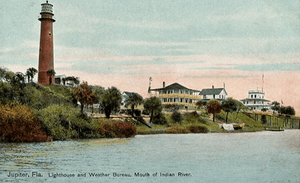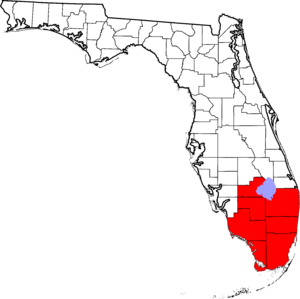National Weather Service Miami, Florida facts for kids
The National Weather Service Miami, Florida is a local office of the National Weather Service (NWS). It helps forecast weather for six counties in South Florida. These counties are Broward, Collier, Glades, Hendry, Miami-Dade, and Palm Beach. It also covers the mainland part of Monroe County.
This office first started in 1879. It was a Signal Corps station near the Jupiter Inlet Light. Later, in 1891, it became a Weather Bureau Office (WBO). The WBO in Jupiter moved to Miami in 1911. This move happened because Miami was growing very fast.
In 1930, another Weather Bureau office opened at Miami Municipal Airport. This airport office later moved to Miami International Airport in 1942. It stayed there until 1975.
Under the leadership of Grady Norton, the main hurricane warning service moved to Miami in 1943. This service later became the National Hurricane Center. In October 1970, the Weather Bureau changed its name to the National Weather Service. So, the WBO Miami became NWS Miami.
In the 1990s, the NWS office in West Palm Beach joined with NWS Miami. Since 1995, the NWS Miami office has been located at Florida International University. It is right next to the National Hurricane Center.
Contents
History of Weather Forecasting in South Florida
Early Days: From Soldiers to Scientists

In 1870, the United States started a weather service within the United States Army. This was the Signal Corps. They opened 22 weather stations. In July 1879, one of these stations opened at the Jupiter Inlet. It was close to the lighthouse.
Other people in the Miami area also kept weather records. These included W. H. Hunt, a state senator, and Ephraim Sturtevant. In 1890, President Benjamin Harrison asked for a new weather group. He wanted the Weather Bureau to be part of the Department of Agriculture.
Less than a year later, the Jupiter Signal Corps station became the Weather Bureau Office (WBO) Jupiter. In the winter of 1894–1895, Jupiter had two very cold freezes. Temperatures dropped to 24 °F (−4 °C) and 27 °F (−3 °C). Because of this cold weather, Henry Flagler decided to extend his Florida East Coast Railway south to Miami.
Moving to Miami
Miami was growing very fast in the early 1900s. So, the WBO in Jupiter closed in May 1911. It moved to Miami about a month later. The new office was in the Bank of Bay Biscayne Building. A 40-foot (12 m) steel tower was built on the roof. This tower helped measure wind direction and speed. In August 1914, the WBO Miami moved again. It went to the Federal Building in Miami.
In October 1944, the Weather Bureau opened a part-time office. This was at Palm Beach Air Force Base in West Palm Beach. This base is now Palm Beach International Airport. The office became full-time in November 1945. It was known as NWS West Palm Beach.
Hurricane Andrew and Modern Changes
Hurricane Andrew hit southern Miami-Dade County on August 24, 1992. The strong winds blew the WSR-57 radar off the roof overnight. Other NWS offices helped out. The offices in Melbourne, Tampa, and West Palm Beach gave forecasts and warnings.
A new radar system, called NEXRAD, was installed in April 1993. It was placed near the Miami MetroZoo. This was earlier than planned. NEXRAD officially started working on April 20, 1995. The next month, NWS Miami and the National Hurricane Center moved. They moved to the campus of Florida International University.
As part of a big plan in the 1990s, NWS West Palm Beach joined with NWS Miami in 1993. In 1997, there was an idea to combine NWS Key West with NWS Miami. But by March 1998, it was decided that NWS Key West would stay a separate office.
Weather Radio for South Florida
The National Weather Service Miami office also provides weather information on NOAA Weather Radio. They broadcast on six stations in South Florida. This helps people get important weather updates.
| City of license | Call sign | Frequency (MHz) |
|---|---|---|
| Miami | KHB34 | 162.550 MHz |
| Miami (Spanish) | WZ2531 | 162.500 MHz |
| Princeton | WNG663 | 162.425 MHz |
| West Palm Beach | KEC50 | 162.475 MHz |
| Naples | WWG92 | 162.525 MHz |
| Belle Glade | WXM58 | 162.400 MHz |



